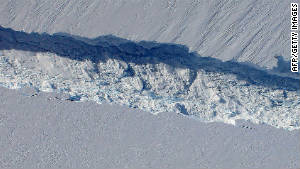- Back to Home »
- City-size iceberg may threaten ships

- Iceberg could last in open ocean for a year, researcher says
- Sea ice that kept berg close to Antarctica now melting, scientist says
- Iceberg separated from glacier in July
(CNN) -- A massive iceberg that broke off an Antarctic glacier in July is now moving toward the open ocean and could pose a threat to busy shipping lanes, researchers reported.
The huge berg is estimated to be about 270 square miles (700 square kilometers) in area, about the size of nation of Singapore or double the size of the city of Atlanta.
"An iceberg that size could survive for a year or longer and it could drift a long way north in that time and end up in the vicinity of world shipping lanes in the Southern Ocean," Robert Marsh, a scientist at the University of Southampton in England, said in a press release this week.
Detecting the dangers of Greenland's giant icebergs

Marsh is part of a team of scientists who have been given an emergency grant to track the iceberg and predict its path so ships traveling through the area can be alerted.
Researchers at the Alfred Wegener Institute, using images from the German Space Agency's TerraSAR-X satellite, reported in July that the iceberg was separating from the Antarctica's Pine Island Glacier. It had been kept close to the glacier by sea ice, another researcher, Grant Bigg from the University of Sheffield, told the BBC. But the end of the Antarctic winter has melted some of the sea ice and given the berg a route to the open ocean, he said.
"In the last couple of days, it has begun to break away and now a kilometer or two of clear water has developed between it and the glacier," Bigg told the BBC.
The calving of the massive berg has been a long process. The crack that produced it was first detected by a NASA plane in October 2011.
The researchers say this will be the first time to track the path of such a massive iceberg, something that will be more important as the effects of global warming increase.
Antarctic ice shelves 'tearing apart,' says study







